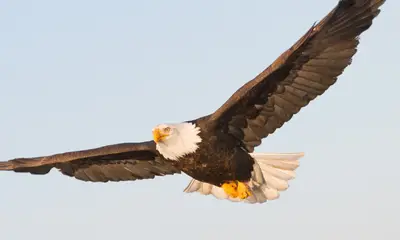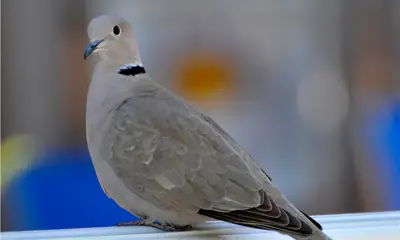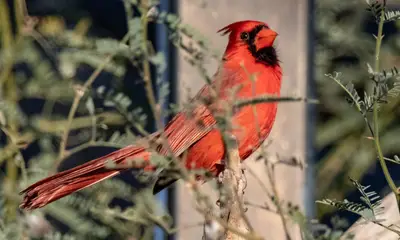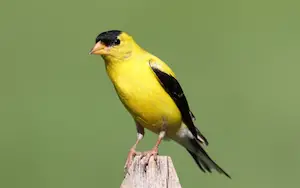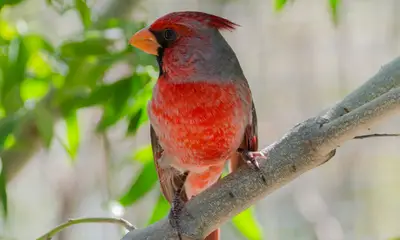13 BLACK Birds With WHITE STRIPES On Wings (Photos & Facts)
Did you spot a black bird with a white stripe on its wing? In that case you’ll probably want to know what species you saw. To help you identify the bird you spotted, we’ll cover the most common types of black birds that have white stripes on their wings. We’ll show you how to identify these birds and cover the key facts to know about each species.
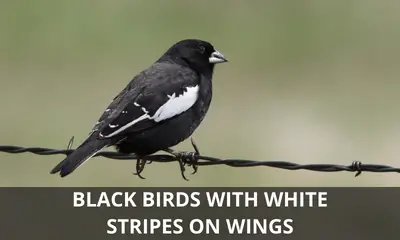
Types of black birds with white stripes on wings
The 13 most common black-colored birds with white stripes on their wings are:
- Lark Bunting
- Yellow-headed Blackbird
- Downy Woodpecker
- Black-and-white Warbler
- Hairy Woodpecker
- Yellow-bellied Sapsucker
- Tricolored Blackbird
- Anhinga
- White-headed Woodpecker
- Northern Mockingbird
- Common Nighthawk
- White-browed Wagtail
- Eurasian Magpie
While many of these birds are found in North America, we also included some that hail from other parts of the world.
Now let’s dive into the details, and take a closer look at each of these species in order to get the full scoop:
Lark Bunting
Scientific name: Calamospiza melanocorys
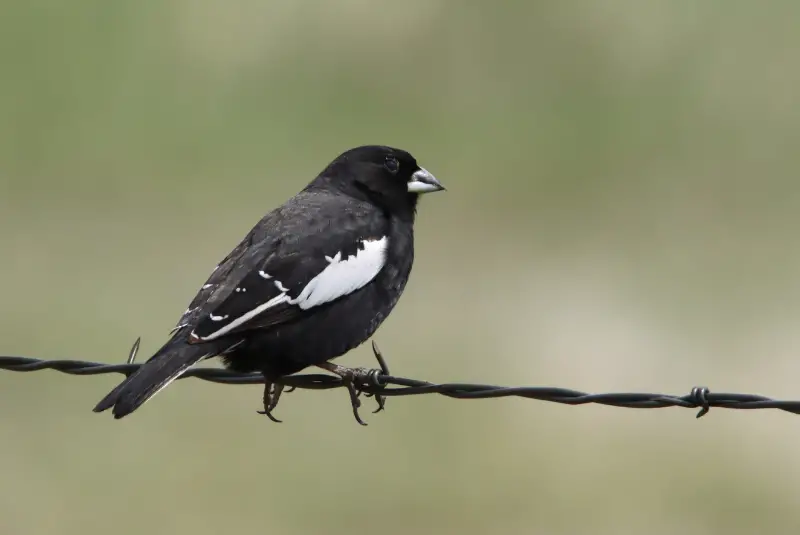
The Lark Bunting is a medium-sized songbird with striking black-and-white coloration in the males.
Male Lark Buntings are entirely black with a bright white stripe on their wings. The females and juveniles, on the other hand, are pale brown with white streaks.
The Lark Bunting is a summer visitor in the central part of North America, with a range that extends northwards up to Canada.
During the fall, it forms large flocks that migrate south together. It winters in Mexico and the southern United States.
The preferred habitat of the Lark Bunting are prairies and grassland, where it forages for seeds and small invertebrates during summer.
Yellow-headed Blackbird
Scientific name: Xanthocephalus xanthocephalus
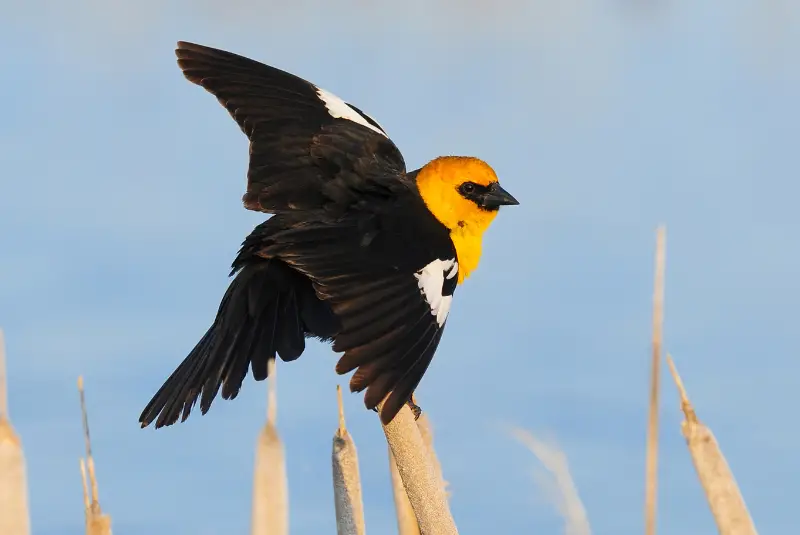
While Yellow-headed Blackbirds are more common throughout the western United States, Illinois is included within the eastern edge of their range.
Adult males stand out thanks to their distinctive yellow heads and chests, paired with a jet black body.
Females and immatures of this blackbird have drab yellow heads and are dark brown.
Male Yellow-headed Blackbirds will often mate with a number of different females during the breeding season, forming small colonies of nests.
Outside of the breeding season, these black-colored birds gather into massive flocks, frequently mingling with other species of blackbirds, and feed on leftover grains on farmland.
At this time it is common for these birds to forage in fields and spend their winters in open cultivated areas.
During the summer months, they feed mostly on insects and other small invertebrates.
Typically, Yellow-headed Blackbirds breed in lowland areas with wetlands and dense growth of cattails.
In large parts of the United States, this black-colored bird is only observed during migration in fall and spring.
Downy Woodpecker
Scientific name: Picoides pubescens

The Downy Woodpecker is the smallest woodpecker found in North America.
While males are black and white with a small red patch on their nape, females are entirely black and white.
The wings of these birds are black with white stripes, which resemble spots when the wings are folded.
Downy Woodpeckers are non-migratory, and can be seen all year round throughout North America, except for arid regions in southern states.
You can tell this bird apart from the similar Hairy Woodpecker by its smaller size and short beak.
While Downy Woodpeckers don’t migrate, they like to move around outside of the breeding season, in search of areas with plentiful food.
Their preferred habitat is deciduous or mixed forest, where they feed on insects and insect larvae found under the bark of trees. During winter they also eat berries and seeds.
Black-and-white Warbler
Scientific name: Mniotilta varia
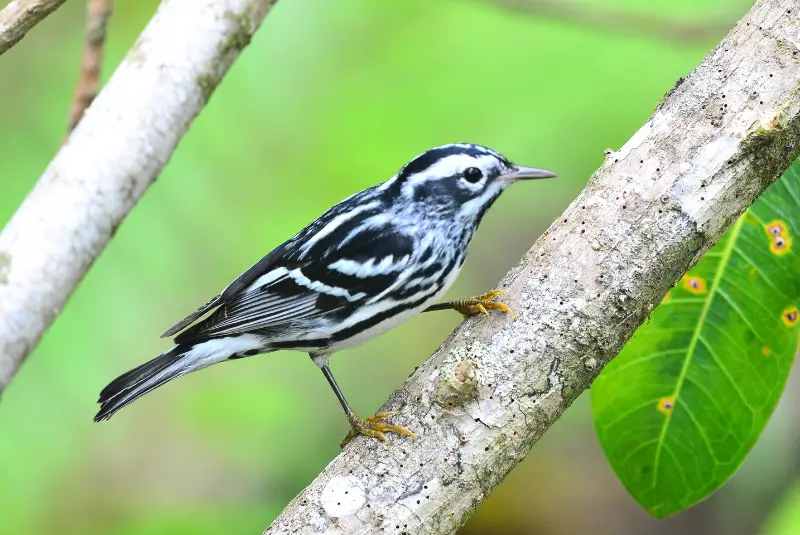
The Black-and-white Warbler has black upperparts with white stripes, as well as black wings with two white wing stripes.
When the wings are folded, the white stripes look more like white streaks or speckles.
Unlike many other warblers, female Black-and-white Warblers look very similar to the males, except for lacking the dark patch behind and below their eye, which increases the white area on their head.
The Black and White Warbler is a breeding bird in the eastern parts of North America, where it can be found from May to August from Canada in the north, to Texas in the south.
This bird is a seasonal migrant that spends the winter in Central America, with a small percentage of its population wintering in Florida and the Gulf Coast.
It can be found in a range of diverse forest habitats, and feeds on small insects and other invertebrates.
Hairy Woodpecker
Scientific name: Picoides villosus

The Hairy Woodpecker looks similar to the Downy Woodpecker, but has a longer, thicker bill, and is a much larger bird overall.
Both the male and the female have black upperparts with white stripes consisting of white feathers on the wings (though they look more like spots when the wings are folded).
The male has a very small red patch on the back of its head, which is considerably smaller than the red patches on other woodpecker species.
The Hairy Woodpecker is a common breeding bird found throughout North America, and is a year-round resident.
This woodpecker breeds in both coniferous and deciduous forests, and is even found in parks and other urban areas with trees.
Yellow-bellied Sapsucker
Scientific name: Sphyrapicus varius
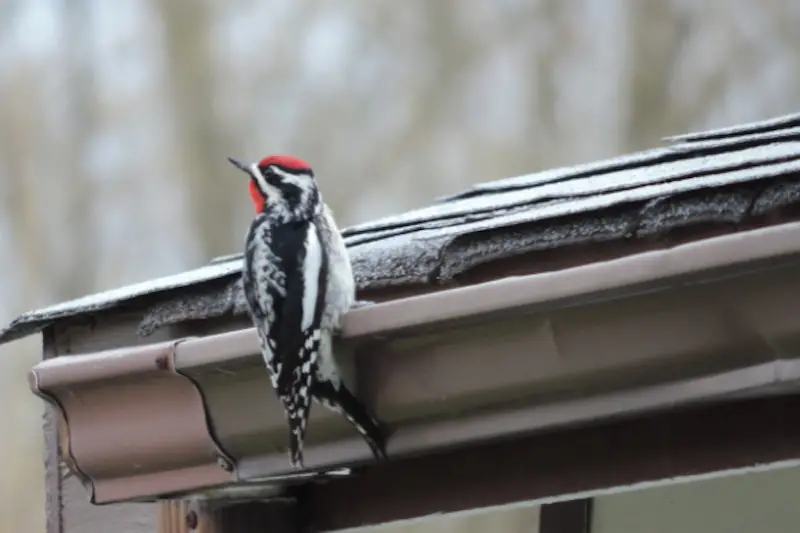
The Yellow-bellied Sapsucker is a winter visitor in Illinois that can be seen on migration in the northern part of Illinois, and wintering in the southern part.
The male has a checkered back with a scarlet red crown, forehead, and chin. It also has a yellowish tinge on its belly and chest. The female looks similar to the male, but has a white chin.
The Yellow-bellied Sapsucker is found in small forests, as well as rural and suburban areas.
This bird drills holes into trees in order to drink the sap that oozes out, which it. The bleeding sap also attracts insects, which the Yellow-bellied Sapsucker feeds on.
Tricolored Blackbird
Scientific name: Agelaius tricolor
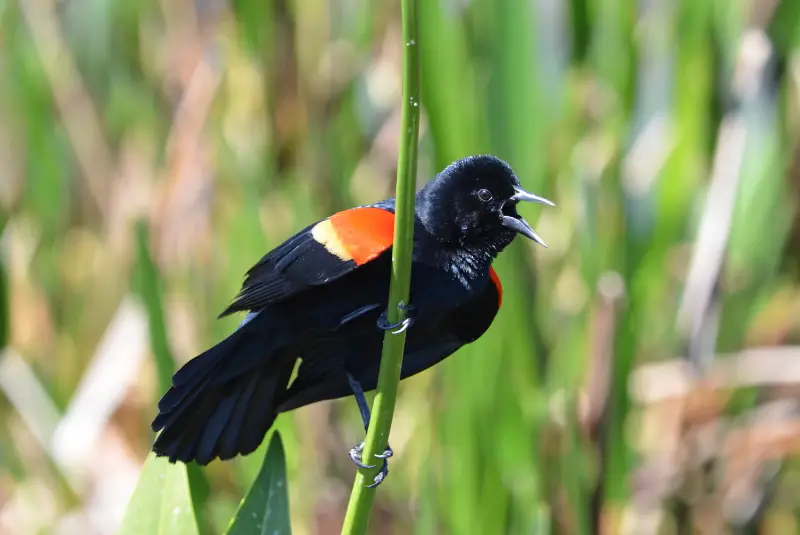
Male Tricolored Blackbirds look superficially similar to Red-winged Blackbirds. Their whole body is iridescent black, except for a small red shoulder streak with a prominent white stripe underneath it.
They can be distinguished from Red-winged Blackbirds by virtue of their smaller red shoulder patch, as well as the large white stripe underneath it.
These black-colored birds used to be very common in California, with flocks that numbered in the millions.
However, due to the extensive destruction of coastal swamps and marshes, they are now an endangered species, with less than forty thousand adults accounting for the entire California population.
Fortunately, Tricolored Blackbirds have started breeding in agricultural areas in addition to marshes, which means there is hope for the survival of this species.
Anhinga
Scientific name: Anhinga anhinga
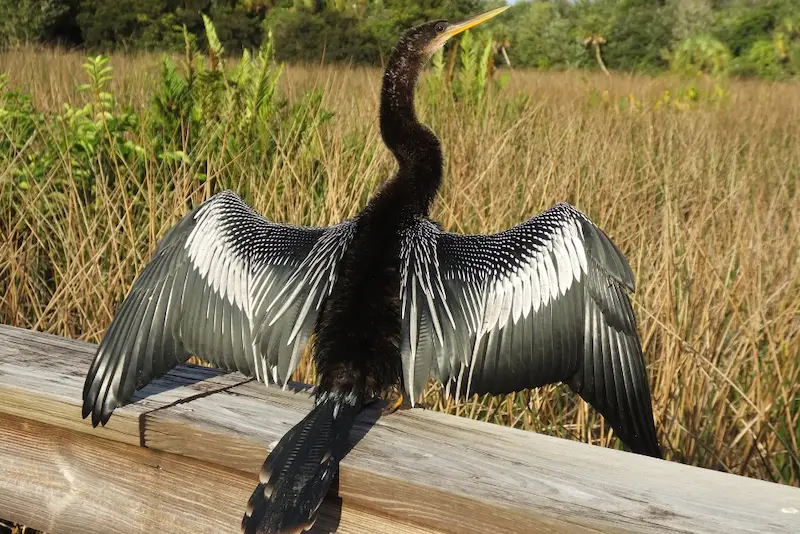
The Anhinga looks similar to a cormorant, but has a snake-like neck, which it uses to catch fish underwater.
When this black-colored bird is in the water, it’s common to see only the head and neck protruding above the water surface.
Adult male Anhingas are largely black, while females have a dark gray body with a brown head and neck.
Both sexes have white stripes on their wings that look like white speckles when the wings are folded.
It lives in swamps and freshwater ponds, and is a year-round resident in the southern part of its North American range.
They are skilled underwater hunters that mainly feed on fish, but also catch a variety of other small animals.
White-headed Woodpecker
Scientific name: Dryobates albolarvatus
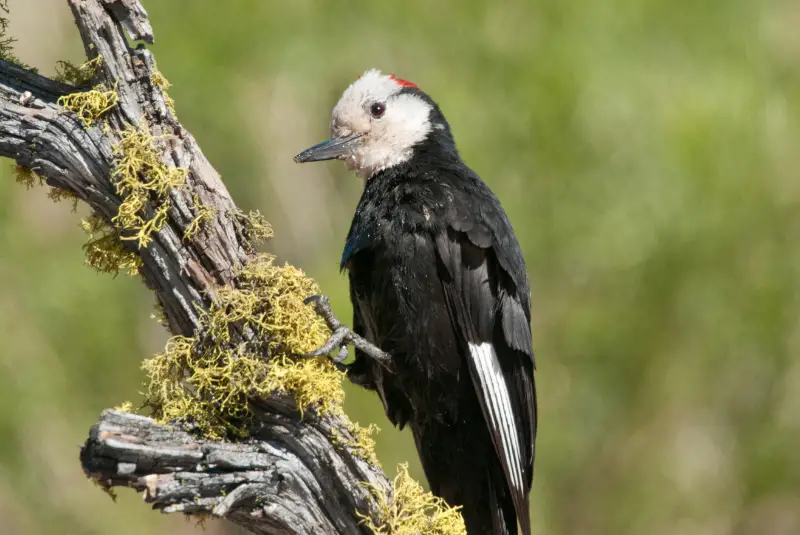
The White-headed Woodpecker is a bird of the western United States, where it is found in mountainous areas.
This medium-sized woodpecker is almost entirely black, except for a white head and a white stripe on the wing. In addition to this, males also have a bright red patch on the rear part of their head.
These woodpeckers live in pine forests, where they forage for seeds by hammering seeds out of pine cones.
Similar to other woodpeckers, they also eat insects and larvae that they find underneath tree bark, and will also eat tree sap. Insects dominate their diet during the breeding season.
These woodpeckers are non-migratory and monogamous, spending their whole lives in the same territory.
Northern Mockingbird
Scientific name: Mimus polyglottos
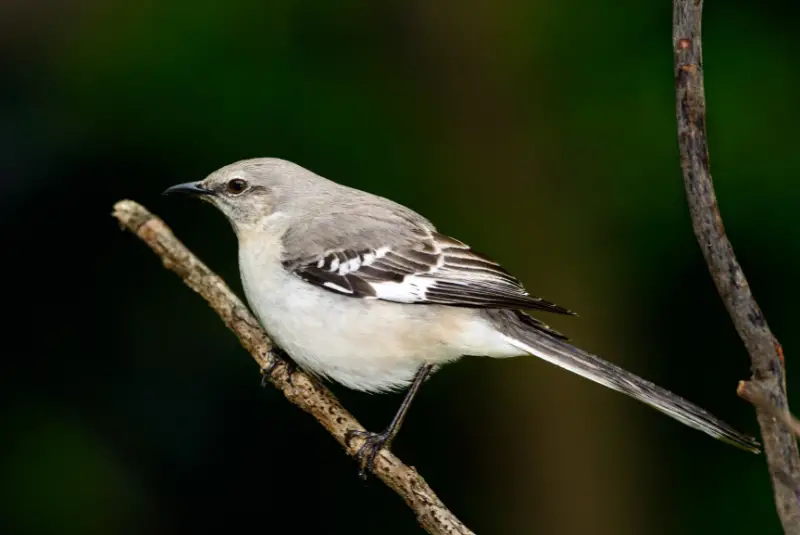
While the Northern Mockingbird is not an entirely black bird, its overall appearance is veery dark gray with blackish wings that have bright white stripes.
The white stripes on the black wings are especially conspicuous in flight, when they flash like bright signals.
It is a common songbird, with both sexes resembling each other. In addition to the dark wings, the tail is also black, and has white margins.
It has a dark eyestripe that contrasts with the yellow eye, while the underparts are buff white. Juveniles look similar to adults, but are covered with spots and streaks.
The Northern Mockingbird is a common backyard bird, and a year-round resident bird across most of the USA. It is also a summer visitor in the northernmost states as well as Canada.
This is the only mockingbird species found in North America. It prefers wooded areas as well as urban habitats with sufficient tree growth, such as parks and golf courses. You can find our in-depth guide to the Northern Mockingbird here!
Common Nighthawk
Scientific name: Chordeiles minor
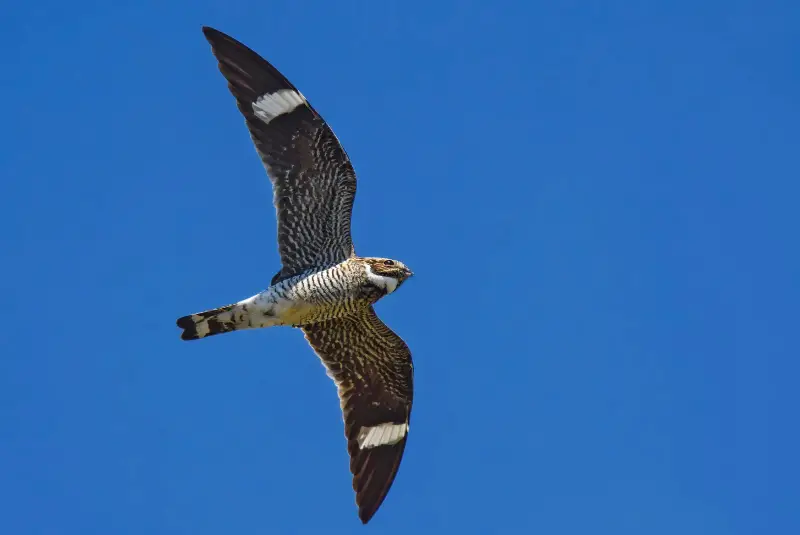
Similar to the Northern Mockingbird, the Common Nighthawk is not black, but dark brown instead.
However, the wings are very dark brown, and have a bright white bar that is very conspicuous during flight.
Nighthawks are most active at dusk and dawn, and if you see one in low light conditions, it looks like a black bird with white stripes on its wing.
The Common Nighthawk is a breeding bird all overy North America, but it is a strict migratory species, and spends the winter in South America.
It breeds in a wide variety of open woodland habitats, including urban areas. It feeds on insects that it catches in flight.
White-browed Wagtail
Scientific name: Motacilla maderaspatensis
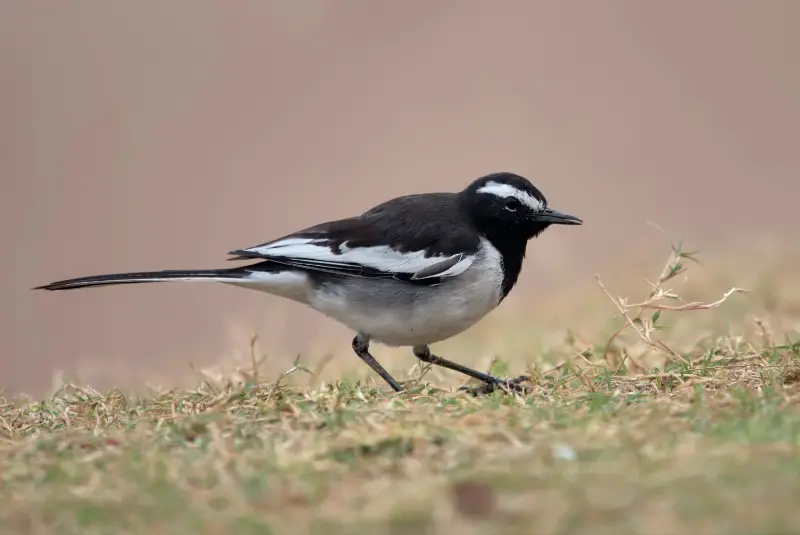
The White-browed Wagtail is a bird of the Indian subcontinent, where it can be found year-round.
Adult males and females look similar, and have an almost entirely black upperside, except for a white eyebrow and a broad white bar on the wing. Immatures are more brownish.
It frequents wooded areas in direct proximity to water, including marshes, lakes, and riversides. Also found in urban areas.
Similar to other wagtails, it likes to wag its tail, and can be easily recognized by its undulating wave-shaped flight.
These birds are predominantly insectivorous, but also feed on other small invertebrates.
Eurasian Magpie
Scientific name: Pica pica

The Eurasian Magpie is easily recognizable due to its long tail and black and white colored plumage, including its black wings with a large white shoulder patch.
This is a common bird throughout Europe and Asia, where it breeds in urban areas as well as remote woodlands.
Magpies like to forage in groups of up to 15 birds outside of the breeding season. In secluded areas they are shy birds that are rarely seen, but in urban habitats they lose all fear of human beings.
Due to its poor flying skills, the Magpie prefers to stay close to trees and shrubs that it can use as cover in case of aerial pursuit by a hawk.
This is a highly intelligent species, which explains why it thrives in a wide range of diverse habitats, which even include islands without tree growth.
What black birds have white stripes on their wings and tails?
Black-colored birds that have white stripes on both their wings and tails are usually woodpeckers that belong to one of several species displaying this type of black and white striped coloration.
Some of the most common woodpeckers with this color pattern are the Downy Woodpecker, Hairy Woodpecker, Yellow-bellied Sapsucker, as well as the Ladder-Backed Woodpecker (which is native to the southwestern United States).
Final remarks
This concludes our guide to black birds with white stripes on wings. Hopefully, this will help you to identify these species the next time you spot them in the wild!


